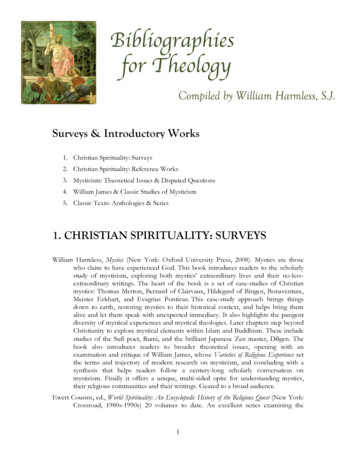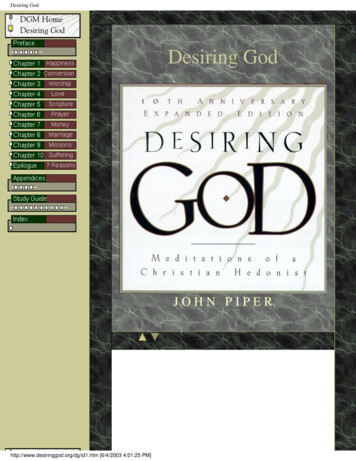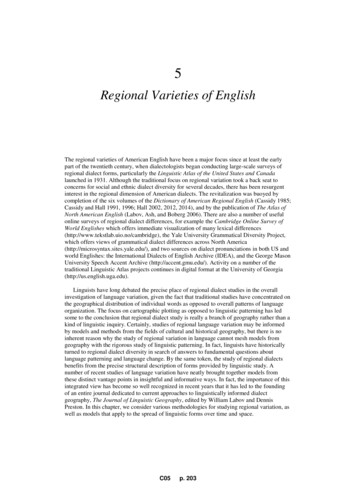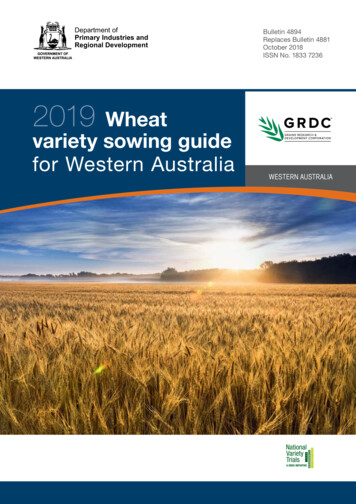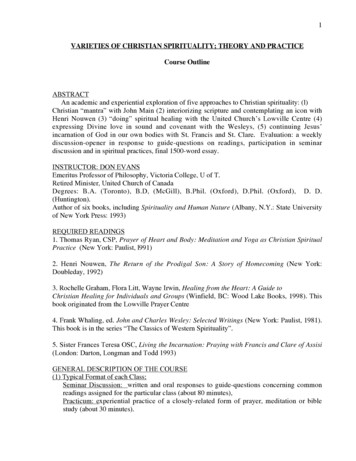
Transcription
1VARIETIES OF CHRISTIAN SPIRITUALITY; THEORY AND PRACTICECourse OutlineABSTRACTAn academic and experiential exploration of five approaches to Christian spirituality: (l)Christian “mantra” with John Main (2) interiorizing scripture and contemplating an icon withHenri Nouwen (3) “doing” spiritual healing with the United Church’s Lowville Centre (4)expressing Divine love in sound and covenant with the Wesleys, (5) continuing Jesus’incarnation of God in our own bodies with St. Francis and St. Clare. Evaluation: a weeklydiscussion-opener in response to guide-questions on readings, participation in seminardiscussion and in spiritual practices, final 1500-word essay.INSTRUCTOR: DON EVANSEmeritus Professor of Philosophy, Victoria College, U of T.Retired Minister, United Church of CanadaDegrees: B.A. (Toronto), B.D, (McGill), B.Phil. (Oxford), D.Phil. (Oxford), D. D.(Huntington).Author of six books, including Spirituality and Human Nature (Albany, N.Y.: State Universityof New York Press: 1993)REQUIRED READINGS1. Thomas Ryan, CSP, Prayer of Heart and Body: Meditation and Yoga as Christian SpiritualPractice (New York: Paulist, l991)2. Henri Nouwen, The Return of the Prodigal Son: A Story of Homecoming (New York:Doubleday, 1992)3. Rochelle Graham, Flora Litt, Wayne Irwin, Healing from the Heart: A Guide toChristian Healing for Individuals and Groups (Winfield, BC: Wood Lake Books, 1998). Thisbook originated from the Lowville Prayer Centre4. Frank Whaling, ed. John and Charles Wesley: Selected Writings (New York: Paulist, 1981).This book is in the series “The Classics of Western Spirituality”.5. Sister Frances Teresa OSC, Living the Incarnation: Praying with Francis and Clare of Assisi(London: Darton, Longman and Todd 1993)GENERAL DESCRIPTION OF THE COURSE(1) Typical Format of each Class;Seminar Discussion: written and oral responses to guide-questions concerning commonreadings assigned for the particular class (about 80 minutes),Practicum: experiential practice of a closely-related form of prayer, meditation or biblestudy (about 30 minutes).
2(2) Selection of the Five BooksThe course does not purport to provide an overall survey of Christian spirituality. Somevery significant Christian approaches have been omitted because they are already available oncampus, e.g. spiritual discernment in the Ignatian tradition and biblical studies in the Reformedtradition. One criterion in selecting the books is that each book can be explored experientiallythrough closely related spiritual practices that are feasible in the classroom and in private.In so far as the course has a particular theological emphasis it is the Wesleyan andFranciscan invitation, in this human, embodied life, to partake of the divine nature, i.e. divineLove. Nevertheless alternative emphases are welcome, and each student is encouraged todiscover which combination of approaches seems most appropriate to him or her.The spiritual practices explored in the Practicum are diverse, for the instructor isconvinced that there is no ONE practice that is the best for every person; indeed, what is bestfor each individual often varies as life-contexts change.(3) Important Issues which are Not Central in the course(i)Non-Christian Spiritual Practices: The course is deliberately focused ondistinctively Christian practices, with only incidental references to Christian useof non-Christian practices such as Yoga or Therapeutic Touch.(ii)Differences in Gender and in Sexual Orientation: Distinctive spiritualities mayarise from differences in gender and/or sexual orientation. This will be discussedbriefly in response to guide-questions on readings from Nouwen and SisterTeresa,(iii) Activism concerning Social Injustice and Environmental Exploitation: For somecontemporary Christian spiritualities this is central, and in the instructor’s lifeand writings it has been important. It is explored, however, in other TST courses.In this course we will only briefly consider some implications of personalpractices for activism when we discuss the Wesleys and St. Francis.(iv)Psychotherapeutic Dimensions of Spirituality: Although the instructor haspublished extensively concerning this, it will not be a focus of the course for it isthe focus in other TST courses. Nevertheless it is clear that Nouwen and SisterTeresa draw implicitly on considerable psychotherapeutic wisdom.(v)Life-Crises and Suffering as Opportunities for Spiritual Growth. This issue israised by one guide-question on St. Clare’s process of mourning. If the coursecould be longer, a whole book and extensive Practicums would be devoted to it,for it is very significant in the spiritual formation of individuals. (For one suchbook see under ”Cynthia Crysdale” in the Bibliography.)COURSE REQUIREMENTS(l) Discussion –Openers ( 200-250 words – 50% of the final mark)
3Each discussion-opener is due at the class for which is had been assigned; no latersubmissions are accepted. Each discussion-opener is a mini-essay response to a guide-question.A total of TEN discussion-openers are required, each worth 5% of the overall final markfor the course. If a student submits more than t en, the BEST 10 will be considered incalculating the final mark.(2) Final Essay (1500 words - 15 % of the final mark)(A) “Personal-reflection” essay, outlining any changes in your ownunderstanding of Christian spirituality in response to the course.(B) “ Topic-focused” essay, exploring a particular book or issue in the coursemore extensively than in your mini-essays.Submit (A) OR (B).(3) Seminar Discussion (20% of the final mark)This will be evaluated less on the quantity than on the quality of a student’scontributions to discussion. The quality involves many elements: clarity, brevity, originality,insight into the text or the issues, pertinence in relation to other students’ remarks, etc. Frequentabsence from class reduces the overall mark for class discussion.If in addition to having prepared a written mini-essay you speak from notes in responseto another guide-question, this could improve your grade for class discussion.(4) Practicum Participation (l5% of the final mark)Because of the difficulty in assigning a mark to someone’s meditation or prayer,students will receive an automatic mark of l% for each practicum session they attend (possibletotal of l3 classes). Also, if a person reports considerable private involvement during the weeks,this can increase the Practicum mark.A Note Concerning Regular Attendance and Writing of Mini-Essays:If you suspect in advance that you cannot count on regular preparation and regularattendance you would be unwise to take this course. A last-minute flurry of activity at the endof term is unlikely to salvage your mark, as it might in some courses.Nevertheless, if towards the end of term you find that you have missed more than a fewclasses and/or mini-essay deadlines you can gamble on writing a high-mark final essay (Topic(B)) that is twice as long (3000 words) and having it count for 30% of the final overall coursemark, reducing the weighting for the mini-essays to 40% and for the seminar discussion to l5%.If your longer final essay is first-class, this could raise your overall final mark by 4 to 5 marks;but it is better not to gamble on this possible option in advance.Some Information Concerning Discussion-Opener Mini-Essays:1. Notes do not count as a mini-essay. Your whole answer should be legible and ready tohand in at the end of class.2. GUIDE-QUESTION ANSWERS ARE NOT ACCEPTED AFTER THE CLASS, evenon the same day; they are acceptable BEFORE class (Room l04, Old Victoria Building)or at the end of class.
43. Focus on the assigned guide-question. If you want to raise a different issue, do so orallyin class discussion.4. Assume that everyone has read the assigned text, so that you need only summarize orexplain to the extent that this is necessary in making your point. Try to provide a clearand stimulating initial basis for class discussion rather than a comprehensive survey.Avoid long introductions; plunge right in instead. Answers do not have to “settle” anissue; they can be exploratory probes.5. Supplementary reading is not required and is, indeed discouraged. Devote your timeinstead to REFLECTION in response to the assigned readings and to WRITING theanswers to guide-questions. The course Bibliography is for possible follow-up AFTERthe course.6. Do not discard your marked answers. Keep them to check the instructor’s tally later on.7. Although you should be as accurate and fair as possible in presenting the views of anauthor, at times (where interpretation is very difficult) you can resort to saying, “IF thisis what s/he means, then I agree – or disagree – for the following reasons”.SOME BACKGROUND INFORMATION CONCERNING THE INSTRUCTOR(1) Brief Curriculum VitaeDon Evans is Emeritus Professor of Philosophy at Victoria College, University ofToronto. He is also a retired minister in the United Church of Canada. Born in Fort William(now Thunder Bay) Ontario in l927, he graduated in Philosophy and English from theUniversity of Toronto in l950.He studied philosophy and philosophy of religion at Oxford University for five yearsand received two graduate degrees there (B.Phil. and D.Phil.).He also studied theology at McGill University (B.D. 1955), was ordained as a ministerin the United Church of Canada and served a congregation at Grand Forks, B.C. 1955-58.During the l960s he was active in the national Committees on International Affairs (writing onSouth Africa) and on Christian Faith (helping to write the new United Church Creed).Having taught in the McGill Faculty of Divinity 1960-64, he moved to the Department ofPhilosophy at University of Toronto where he taught until official retirement in l993(philosophy of religion, of mysticism, of human nature, of social issues, of existentialism, andof ethics). Since then he has been regularly teaching two sections of a first-year seminar course,“Human Nature in Great Literature” at Victoria College.(2) Writings and Workshops on SpiritualitySince l958 he has presented over a hundred papers at various conferences and universitiesand he has published over fifty essays and six books, including Peace, Power and Protest:Ethics and International Affairs (Toronto: Ryerson, 1967), Communist Faith and ChristianFaith (Toronto: Ryerson, 1964).Spirituality became a central focus in most of his presentations and essays from about1982 onwards. His studies through the 1980s culminated in Spirituality and Human Nature(Albany, N.Y.: State University of New York Press, 1993).
5Workshops on varieties of meditation also started to be frequent in about l982. He hasled hundreds of introductory and advanced sessions in diverse settings, which have includedChristian centres such as: Toronto School of Theology, Continuing Education (15 workshops)Five Oaks Retreat Centre and Cedar Glen Retreat CentreIgnatius College, Guelph (co-led with John Veltri, S.J.)Metropolitan Community Church, TorontoHuntington University, Sudbury (5 workshops)Spiritual healing has become especially important for Don Evans in recent years.Recently he helped initiate and co-led a Sunday evening healing service at Aurora UnitedChurch. He has also offered a workshop on “Transformative Meditations for Spiritual Healers”six times: twice at TST Continuing Education; at a hospice in Devon, England; at HuntingtonCollege, Sudbury; for interested people in Stratford, Ontario; and for the patients of a cancerpsychotherapist.(3) Personal Spiritual PathFor over thirty years he has been involved continuously in intensive processes ofpersonal change, exploring many varieties of meditation and prayer. While open to learningfrom non–Christian paths (Buddhist, Hindu, Sufi, Shamanic) his path is centrally Christian.Indeed, the core is a continuous openness to the bodily indwelling of the crucified andresurrected Christ. A special emphasis for twenty years has been healing the rifts between menand women and between the masculine and feminine within all of us.WHAT HAPPENS AT THE FIRST (INTRODUCTORY) SESSIONNo prior preparation is required. The instructor will explain the course and respond to questions concerning the courseoutline.The students will introduce themselves briefly or at length, in relation to their hopes andapprehensions concerning the course.The instructor will introduce students to some varieties of concentrative contemplation,including “Christian mantra”.WHAT HAPPENS BEFORE AND DURING EACH SUBSEQUENT SESSIONIn PREPARATION for the session, students read the assigned pages and write adiscussion-opener to present at class; students also engage in the spiritualpractice assigned for the week leading up to the session.
6DURING the session (usually at the end) the instructor introduces a new spiritualpractice, that is, a new “Practicum”.A NOTE CONCERNING PAGE REFERENCES IN THIS COURSE OUTLINEEach page is divided into four parts: a, b, c, d. So “43c” means “the third quarter ofpage 43”, and “89b” means “the second quarter of page 89”.SECOND SESSION (On Thomas Ryan’s Prayer of Heart and Body)Preparation for Class Discussion, including Written Responses to Guide-Questions:Read Ryan, pages l-6l and chapters 7, 8, 9. Reflect concerning all the followingquestions. Prepare a written discussion-opener to submit at class in response to #1 OR #2.1. Read Ryan pages l-6l. Many different theological and spiritual perspectives andemphases are presented here. For you at this time which seem to you least relevant toyour current conception of Christian spirituality? Which most relevant? WHY?2. Read Ryan chapter 7,8,9. Explain and discuss ONE of the following quotations in itscontext:(i)(ii)(iii)(iv)(v)“We would be a lot kinder to ourselves and more realistic if we did not evenwish to be completely free of potentially distracting thoughts in meditation”(9la)“In living more and more out of this center, we come to realize that there isreally only one prayer that is offered: the breath of love that flows constantlybetween Jesus and his Father. This breath, this stream of love, is the HolySpirit.” (98c)“It is only the clinging to things that reduces the free flow of God’s grace andthat hinders our growth in God’s love” (103c)“If we only follow the saints and mystics who have ‘seen’ God, but have noexperience of God ourselves, we will drop out of the race” (108d)“Meditation invites one to come to a personal experience of what Paulproclaims: our redemption is accomplished Salvation means being takenutterly beyond ourselves into the limitless love and freedom of the Spirit ofGod” (ll0b)Preparation for Second Session through Daily PracticumRead Ryan l8d-l9a, 302d-303d and chapters 5 and 6. Drawing on the Practicumintroduced at the first Class Session and on these readings, practice“Maranatha” (66a-71a) and/or your own chosen version of concentrative contemplation.New Practicum during the Second SessionThe instructor will lead in a brief period of contemplation, followed by a briefdiscussion with students concerning insights or difficulties that arose during the week precedingthis Session. Then he will introduce some yoga postures and yoga breathing.
7THIRD SESSION (second and final session on Ryan’s book)Preparation for Class Discussion, including Written Responses to Guide-QuestionsRead Ryan, chapters 10, 11, l2 13. Reflect concerning all the following quotations.Prepare a discussion-opener in which you explain and discuss ONE of them:(i)“Inasmuch as the Eastern religions have given more place to the intuitivethan to the rational ways of knowing in their approach to the Mystery of God,they have lessons to teach. One of their insights is that the way to discoverand to experience is not by systematic argument but by self-surrender.”(123c)(ii)“Actually, the physical postures are to be considered the external vehicle ofthe more significant ‘inner posture’ –the experience of inner stillness andharmony.” (138c)(iii) “The Word became flesh. In the Incarnation, Jesus in his flesh took theworld as part of himself. The world quite literally became the body of God.Since God is identified with and discovered within this bodiliness, thefleshiness, this materiality, this sensuality life in this world is the life ofGod . This corporeal nature is the place that God chose to call ‘home’.What we are doing is discovering in yoga a concrete application of ourincarnation faith . Our embodied nature is like a hologram of God’s cosmicdivine embodiment.” (144d, 145a, 145d)(iv)“What makes a particular practice Christian is not its nature, but its intent.”(149d)(v)“The yogic concept of having a certain quality of being as the source ofaction has much to show the Christian about the appropriate attitude towardsgrace. So much more of the kingdom of God can be actualized in our livesby being open to the flow of grace than by straining after specific results.”(181b)Preparation for Third Session through Daily PracticumPractice the yoga postures and yoga breathing learned at the second session. Also readand apply whatever seems appropriate in Ryan chapter 5, especially 192a-193d; also, from150d-155d and 235b-240a.New Practicum During the Third SessionThe instructor will review with students their practice of yoga postures and yogabreathing and then will introduce a new meditation: surrendering into the Divine Mystery.FOURTH SESSION (On Henri Nouwen’s The Return of the Prodigal Son)Preparation for Class Discussion, including Written Responses to Guide-QuestionsRead pages l-23 and chapters 1, 2 and 3. Reflect concerning all the following questions.Prepare a written discussion-opener to submit at class in response to either #l or #2:1. Read pages ll-23. Having read thus far, with which of the following characters inRembrandt’s painting do you identify yourself MOST and LEAST? Why?
8(i)(ii)(iii)(iv)one of the four bystandersthe younger sonthe elder sonthe father.2. Read chapters 1,2 and 3 concerning the younger son. Explain and discuss ONE of thefollowing, in its context:(i)“Leaving home is living as though I do not yet have a home and must lookfar and wide to find one The addicted life can aptly be designated a lifelived ‘in a distant country’.” (37d, 43b)(ii)“When finally the friendship broke down completely I had to choose betweendestroying myself or trusting that the love I was looking for did, in fact,exist back home! A voice, weak as it seemed, whispered that no humanbeing would ever be able to give me the love I craved.” (49d, 5la)(iii) “There is repentance, but not a repentance in the light of the immense love ofa forgiving God One of the greatest challenge of the spiritual life is toreceive God’s forgiveness.” (52d, 53a)Preparation for the Fourth Session Through Daily Practicum Select a Gospel story about Jesus or a saying by him. Prepare for reading it by meditating for five or ten minutes, using Christian mantraand/or yoga posture and/or yoga breathing. “Listen” as you read, and after you read, for a “message” (verbal or non-verbal).New Practicum during the Fourth SessionThe instructor will introduce a response to Luke’s story of Jesus’ Transfiguration,following Nouwen’s example by identifying with each character in the story and also bycontemplating an icon (in this instance not by Rembrandt but by Fra Angelica).FIFTH SESSION (second of three on Nouwen)Preparation for Class Discussion, including Written Responses to Guide-QuestionsRead Nouwen, chapters 4 through 9. Reflect concerning all the following questions.Prepare a written discussion-opener to submit at class in response to #1 or #2.1. Read chapters 4, 5 and 6 and pages 103d-107a. Explain and discuss ONE of thefollowing, in its context:(i)(ii)“The lostness of the resentful ‘saint’ is so hard to reach precisely because it isso closely wedded to the desire to be good and virtuous.” (71d)“All of my inner complaints about not being accepted, liked and loved surgedup in me, and I left the room, slamming the door behind me. I wascompletely incapacitated – unable to receive and participate in the joy thatwas there”. (73d)
9(iii)(iv)“Although we are incapable of liberating ourselves from frozen anger, wecan allow ourselves to be found by God and healed by his love through theconcrete and daily practice of trust and gratitude”. (84a, my italics)“God looks at his people as children of a family who are happy that thosewho have done only a little bit are as much loved as those who accomplishmost Do I believe that there is a real desire in God to simply be with me?”(104c, 107b)2. Read chapters 7,8 and 9, focusing mainly on pages 107d-119b. Explain and discussONE of the following, in its context:(i)(ii)(iii)“For a long time I considered low self-esteem to be some kind of virtue But now I realize that the real sin is to deny God’s love for me, to ignore myoriginal goodness.” (107d)“The Father dresses his son with the signs of freedom, the freedom of thechildren of God. He does not want any of them to be hired servants orslaves. He wants them to wear the robe of honour, the ring of inheritance,and the footwear of prestige As the returned child of God, living in theFather’s house, God’s joy is mine to claim My Father has already dressedme with a cloak, ring and sandals” (111d-112a, 118d)“When Jesus speaks about the world, he is very realistic. He speaks aboutwars and revolutions, earthquakes, plagues and famines, persecution andimprisonment, betrayal, hatred and assassinations. There is no suggestion atall that these signs of the world’s darkness will ever be absent. But still,God’s joy can be ours in the midst of it all People who have come to knowthe joy of God do not deny the darkness, but they choose not to live init Every choice for joy in turn reveals more joy.” (116d, 117d, 118a). (Butsee also 128d-129b concerning grief.)Preparation for the Fifth Session through Daily PracticumConcerning the Prodigal Son and/or the Transfiguration and/or another Gospel story: (i)meditate in preparation (ii) read aloud to yourself (iii) Identify yourself with each character inturn and be open to any disclosures concerning yourself. (Use an icon if this is available andseems appropriate to you.)New Practicum during the Fifth SessionThe instructor will introduce Dr. John Rossiter-Thornton’s “Prayer Wheel”, which helpsus to grow in attitudes that are spiritually positive such as gratitude, forgiveness, trust and love.SIXTH SESSION (last of three on Nouwen)Preparation for Class Discussion, including Written Responses to Guide-Questions:Read Ryan, pages 89-end. Reflect concerning all the following questions. Prepare a writtendiscussion-opener to submit at class in response to either #l or #2.1. Read pages 89-end, focusing especially on pages ll9-l32. Explain and discuss ONE ofthe following, in its context:
10(i)(ii)“As the returned child of God who is invited to resume my place in my Father’shome, the challenge now, yes the call, is to become the Father myself Do I want tobe like the father? Do I want to be not just the one who is being forgiven, but alsothe one who forgives; not just the one who is being welcomed home, but also the onewho welcomes home; not just the one who receives compassion, but the one whooffers it as well? ‘Be compassionate as your Father is compassionate.’” (119,122c, 123a)“Grief, forgiveness and generosity are, then, the three ways by which the image ofthe Father can grow in me. They are three aspects of the Father’s call to be home As a self-rejecting person always in search of affirmation and affection, I find itimpossible to love consistently without asking for something in return. But thediscipline is precisely to give up wanting to accomplish this myself as a heroic feat(rather than receiving the ‘unconditional, forgiving love that the Father offers me’).”(132b, 133c)2. Read pages 89–end, focusing especially on pages 92-l02. Consider the instructor’sreflections and then respond to the questions that he raises.1. Reflections: First I note that Nouwen says, “What gives Rembrandt’s portrayal of thefather such an irresistible power is that the most divine is captured in the most human The spiritual truth is completely enfleshed.” I agree that it is wondrously enfleshed but Iquestion whether any image can be complete that is exclusively MALE. Rembrandtdepicts the compassion ate God as a man. In addition, the deep life-experiences that bothRembrandt and Nouwen bring to the painting are male. And, most controversially, Inote that the story originated from and is exemplified by Jesus, a man. It seems obviousto me that there are distinctive ways in which God’s “feminine side” i.e. experiencedand manifested BODILY through a woman in contrast with a man. For example,Rembrandt’s father-figure does not have a WOMB. Nouwen speaks of a welcome intothe “womb of God (54d, 100d, cf. 4d) but in the story and the painting the welcome isfrom a father. Don’t women typically have more direct experiential access to suchwelcoming, in contrast with the modes of compassionate welcoming typically availablefor men? (In raising such issues I am not criticizing Nouwenfor being sexist.Indeed, the male authority-figure whom he sees in the story and the painting is onewhose authority is based, not on patriarchal power, but on compassion. Moreover,Nouwen discerns strongly feminine and motherly qualities in the father and thereby inFather-God. Obviously Nouwen himself manifests a compassionate authority and asensitive feminine side.)2. Questions:(i)Can any man, even a man who has a sensitive feminine side, adequately manifest thefeminine dimension of the Divine Mystery bodily? Does this not require, as well, abodily manifestation by a woman? (A related, and also controversial, question iswhether there are masculine dimensions that cannot be adequately manifested bodilyby any woman.)(ii)A related but also different question arises concerning our longing for an intimate athomeness with God, loving and being loved and eventually sharing in divine
11compassion, as Nouwen sets forth. Is this longing partly shaped by differences insexual orientation and by differences in personal history? Does what we long for inintimacy with another human being affect what we long for in God?SEVENTH SESSION (first of two on Healing from the Heart)Preparation for Class Discussion, including Written Responses to Guide-QuestionsRead Healing from the Heart: Preface, chapters l, 2, 3, 8 and Appendices C, D, and G.Reflect concerning all the following questions. Prepare a written discussion-opener to submit atclass in response to either #1 or#2:1. Read Preface, chapters l, 2 and 3 and Appendices D and G, all of which encourageChristians to include spiritual healing as part of their calling in various ways. If you believespiritual healing to be part of your calling, briefly outline your own basis for this in relation tothe readings. If you have doubts or reservations concerning this, explain why.2. Read chapter 8 (omitting l31b-140b), chapter 9 and Appendix C. Explain and discussONE of the following quotations:i. “Many of us believe it is up to us to pray in a way that reaches God. Ibelieve we are in the presence of God at all times, and prayer is beingattentive to that presence There is an instinctive longing, a reachingtowards One already known somewhere deep within the soul. Our heartaches spiritually—and perhaps physically—until we acknowledge therelationship with God in which we already exist.” (111d and 112b)ii. “Pray confidently. Prayer without faith lacks power.” (115b) Discuss thisin relation to the contrast between “cure” and “healing” in pages 15 to 20.Should we be confident concerning cure?iii. “I believe that we can find within ourselves the images we need forhealing to occur.” (116d)iv. “Yet we know that in our humanity there is in most of us still a struggleof the ego for control, still some personal block which affects our prayer.We are still in the making. And so, not being perfectly united with themind and heart of Christ, we cannot presume to know the will of God foranother’s life.” (123b; cf.143b)v. “However we wish to name the dark powers of the universe, Christianprayer activates an opposing energy. Therefore we ‘put on the wholearmour of God’ (Ephesians 6:10-17)” If a person is obsessed bydebilitating fears or behavior that neither psychological therapy norstrong prayer can release, then the possibility of a terrorizing spirit mayneed to be considered.” (125c and 145b)vi. “The main hindrance, though, is almost always an unwillingness tosurrender, to hand oneself and one’s life over to God. Only when we docan God help us deal with the other hindrances that we know, and thosethat we may not know.” (127c)
12vii. “How many times had I said to a loved one, with m own heart grieving, ‘Iknow I can’t do anything, but I can be here for you’. God was offeringme that same loving gift. I was honored.” (129)Preparation for the Seventh Session through Daily PracticeChoose one, or several, from among the practices used thus far in the course.Deepen the practice(s) during the week.New Practicum during the Seventh SessionThe instructor will provide an introduction to some of the basics of spiritual healing.EIGHTH SESSION (second of two on Healing from the Heart)Preparation for Class Discussion, including Written Responses to Guide-QuestionsRead Healing from the Heart, chapters 4, 5, 6, 7, 10, 12, l3 and pages l3lb-l40b; perhapsalso Appendices A and B. Reflect concerning the following questions. Prepare a writtendiscussion-opener to submit at class in response to #1 or #2:1. Science and Spiritual Healing. Read Wayne Irwin’s chapters (4,7,10, 13). Howimportant or unimportant is support for spiritual healing from scientific theoryand scientific evidence in relation to your own attitude towards spiritual healing?Explain why in relation to Irwin’s presentations.2. Christian use of non –Christian Healing Practices. Read chapters 5,6,12 andpages l3lb-l40b); perhaps
Ethics and International Affairs (Toronto: Ryerson, 1967), Communist Faith and Christian Faith (Toronto: Ryerson, 1964). Spirituality became a central focus in most of his presentations and essays from about 1982 onwards. His studies through the 1980s culminated in Spirituality and Human Nature (Albany, N.Y.: State University of New York Press .


